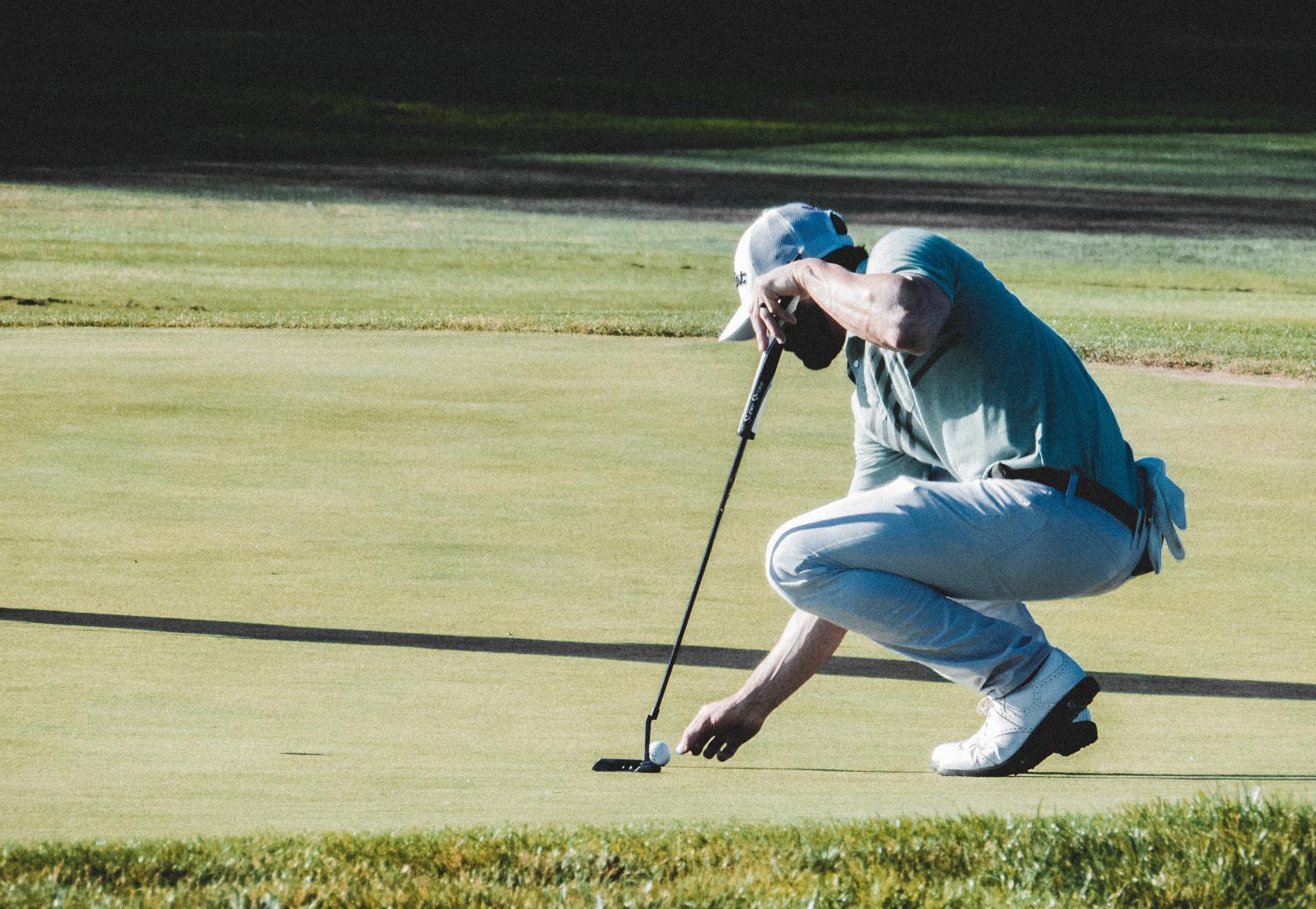Blog Layout
7 Tips To Improve Your Golf
Greg Baresel • September 9, 2020
7 Tips To Improve Your Golf

It's when you start to play golf that you learn fastest. If you have bad golfing habits today, you probably learned them when you first took up golf. But the good news is that anyone can break bad habits and learn good ones. Here are a couple of tips to help you on your way to playing better golf.
1. Your aim is vitally important. If you can't send the ball in the right direction you will never get it in any of the holes. The clubface is the only thing that propels the ball, so line up the clubface with the target first, then take your stance with your feet and shoulders parallel to the target line.
2. Always aim away from potential problems. Tee the ball on the side where the problem is. This will help to keep the ball in play and avoid penalties.
3. Club path is the key too consistency. If your club path is not on plane your contact and direction is going to be inconsistent. When you can get your path on plane or have an in to out swing your contact will improve.
4. Have a go to short game shot. Short game is a part of the game that allows for more creativity. With this comes more options and that requires a lot of practice time to consistently hit the shot on the course. I recommend having a go to short game shot that you can count on the majority of the time. Click here
to watch a video.
5. Get your putt to roll on the intended line. Having a putting stroke that gets your ball to roll toward the target is key to making more putts. Focus on keeping your arms tight to your body to allow the putter to swing on a natural arc.
6. Solid contact will increase your distance. Instead of focusing on increasing your clubhead speed to hit the ball further try to improve your contact first. When you can hit the ball in the center of the clubface your ball speed will increase and that will increase your distance.
7. Improve your score by knowing when it is okay to play it safe. When you find yourself in trouble find the best solution to make bogey or double bogey. The fastest way to improve your score is to eliminate big numbers.

By Greg Baresel
•
March 21, 2020
The fastest way to lowing your scoring average is to practice skill based drills. Skill based drills are drills that simulate as if you are playing golf. Each time you go to practice have a goal in mind for what you would like to achieve for that session. At the end of each session record your results for each drill. The goal is to improve from the previous practice session. Here are three skill based drills you can add to your practice routine.

By Greg Baresel
•
March 12, 2020
As athletes work to prepare for competitions and tournaments, it is very important that nutritional needs be met. This includes both in eating habits, what is consumed, and when it is eaten. The old saying that you should not eat before swimming is a very real concern for athletes regardless of which sport they are involved in.

By Greg Baresel
•
March 12, 2020
Before any golfer, pro or otherwise, picks up a club, they look at the capability of their body versus the requirements of the swing. What exactly does this mean? Most of us are aware that golf requires rotation at the hip joints, shoulder joints and spine. So, what if a golfer has a very tight low back or any restrictions in their shoulders? Well, the obvious answer is that any loss of range of motion creates swing flaws in addition to injuries. This is a fact based on human performance and movement. It is also necessary to create a fluid and natural golf swing. Not only does golf require good rotation at each joint, but it must be efficient and explosive. I have had the opportunity to visit such a human performance center where some of the more famous tour players train. I was able to explore the same tests they take as part of their initial assessment period. Remember since we are all built differently and have different strengths and weaknesses, we all test differently. The results of these tests help guide, direct and prioritize any training program moving forward. How successful is this approach to golf conditioning? I watched it place a green jacket on a well deserving young player just a couple of years ago. What should you be tested for? Muscle strength. Evaluate each significant muscle group. Are there any significant differences between your left side and your right side? Range of Motion. Do you have adequate range of motion in the joints which most affect the golf swing? How does your lower body look versus your upper body? Does your left side match the flexibility in your right? Core strength and endurance. Do you know how to properly engage your core region? If so, for how long? Aerobic capacity and endurance. Do you have what it takes to last through a solid 18 holes? Is there an opportunity for improvement? Balance. Do you have proper balance? Do you know what normal balance for golf looks like? Physical assessment tests similar are commonly used by the top touring pros today. These tests are being offered at some of the top golf performance centers and will surely be the wave of the future. It is your true understanding of your relative strengths and weaknesses that creates opportunities for immediate and sound improvement in your game.

By Greg Baresel
•
March 11, 2020
Many times when you hear people talking about getting the most distance out of their drives or irons, you probably hear the word timing used as they talk about how to achieve this. Or, when you watch the professionals play (especially in person) the distance they achieve seems to come so effortlessly and smooth.

By Greg Baresel
•
July 25, 2019
While most golfers are aware of the fact that the muscles in the lower part of the body are used in the golf swing, many are not aware of just how important these muscles are to the consistent execution of the perfect golf swing.Many do not even realize how imperative it is that muscles used in the golf swing are exercised and kept in tip top condition. Actually, if this is not done, it becomes extremely difficult to for anybody to enjoy the game as too many factors stand in the way of a golfer who does not exercise.For example a common complaint amongst many golfers on the course is that of pain in the lower back which is usually aggravated by golf. This pain is especially evident after longer sessions on the course.How can any golfer improve golf swing, let alone have any hope of enjoying the game with such a nagging, persistent pain? Yet this problem is easily solved by simply strengthening lower back muscles used by doing certain exercises.The result is that there is a higher level of endurance which will also have a tremendous impact on the golf swing of any golfer. Muscles used in the golf swing include some in the lower leg as well as those higher up like the hamstring which is crucial in accomplishing the perfect golf swing.It is a proven fact that muscles used in the golf swing that are not exercised and conditioned on a regular basis with the correct exercise, will usually not respond to the correct golfing techniques.Without being conditioned to obtain the necessary stamina and strength it is unlikely that muscles used in the golf swing will be able to deliver the required performance.Click here to learn more about having your own personal golf fitness program.

By Greg Baresel
•
July 22, 2019
I think we have all been there. You are staring down a long par 4 from the tee box. The fairway is lined with trees on both sides. The landing area is tight and hitting 3 wood or iron is not an option, the hole is too long. You pull out driver and tee up the ball, knowing to win the skin with your buddy you have to land this tee shot in the fairway. You take a few practice swings, address the ball, look down the fairway (it looks a little tighter than before), begin your backswing, and bang! Your body tightens up. You hold onto the club and hook it into the tress. You think to yourself that bogey will now be a good score. You are upset at yourself and watch as your playing partner swings a smooth driver that lands the ball on the left side of the fairway. You begin to grudgingly walk towards your ball, hoping you will find it, saying a few things under your breath, and questioning your swing mechanics. What just happened? A situation that most of us have encountered at some time in our golfing career. We take some smooth practice swings, but when the ball is before us and we have to execute the shot we tighten up and hit a thin or fat shot. We have allowed tension to seep into our golf swing. We all know that the swing is a free-flowing movement that requires your body to be loose. I speak extensively about this with my players on the lesson tee. I discuss how a swing needs to be free and flowing. This allows for the club to travel on the correct swing path and develop club head speed. Muscle tension will impede and ruin your swing. If your muscles are tight, how will you be able to swing a club in a free-flowing manner? You will not be able to do so. If you are gripping the club in your palms with a death grip, how are you going to swing the club freely? You can't. If you are unable to feel the club head, how are you going to swing the club freely? Again, the answer is you will be unable to do so. If you have your doubts, give it a try. Head out to the range, purchase a bucket of balls and go at it! Warm up with a few wedges and then grab your 7-iron. Hit a few half shots and let's begin the experiment. First off, take the club and grip it as hard as you can. Now, attempt to hit the ball. What happened? I am guessing not a good outcome. One more time with our experiment, grab the 7-iron and address the ball. Now, when hitting the ball your thought should be: I am going to hit this ball as hard as I possibly can. Go ahead, try to hit the ball. What happened? Again, I am guessing the outcome was not good. What happened in both of these situations? You developed tension in your forearms, and it impeded your hitting the ball solidly. Next question: how do you develop a smooth, free-flowing swing that is tension-free? Quite a few aspects are part of this equation. Developing proper swing mechanics is part of the answer. The swing is an intricate movement that is the blending of a series of movements into one free-flowing movement. In order to develop a tension-free swing you must develop your swing. This is a process that takes time, proper instruction, and practice. Additionally, you must develop the proper mental confidence in your game. The example in the beginning of this article is a prime example. If you are not mentally confident in your swing, what do you think is going to happen on the tee box? Your body reacts to your mind and tightens up, resulting in a poor swing. How do you develop the mental side of the game? This is again done through the development of your swing, practice, and playing. As your game develops, confidence in your swing will develop. It is a give and take, so to speak. As your golf swing improves, so will the mental aspect of your game. Finally, we must discuss the body. Yes, the body has an effect on a tension-free swing as well. Follow the logic, for muscles to be loose and free-flowing, they must be flexible. Being tight and not flexible puts you in a state of tension even before you get to the first tee! If you do not believe me, go to the gym and do 10 sets of heavy bench presses and then go to the range. See how well or poorly you hit that bucket of balls! If your body is not flexible, you will not be able to perform the free-flowing movements of the swing. The body needs to be flexible for a tension-free swing. If you are inflexible, the ability to even develop your swing mechanics to a point where they are free-flowing will be impossible. Bottom line is you need to develop your flexibility around your swing. How do you go about doing this? The implementation of golf-specific flexibility exercises into a training program will do the trick. The swing and the mind work together to develop a tension-free swing. You cannot develop one without the other. A comprehensive approach is required when developing a tension-free swing. Working only on your swing mechanics will not work if your body is inflexible. Doing only flexibility exercises will not do the trick if your swing mechanics are incorrect. And focusing only on the mental side of the game will not work if your swing is a mess, and your body is as well. A tension-free swing allows for great shots from all over the course. Developing this type of swing takes time and effort. You must train the body, the swing, and the mind. This is the ticket to your tension-free swing. Watch this video to learn more about how to eliminate tension in your swing or to learn more about the mental game of having a calm mind click here.
By Greg Baresel
•
July 13, 2019

By Greg Baresel
•
July 6, 2019
There are some basic elements of the golf swing that the golfer should use as a mental checklist when taking a shot. The first element is the body's alignment toward the target. Stand five to ten feet behind the ball, with the ball directly between your body and the desired target. Locate guidance targets on the ground (leaves, blades of grass, dirt, etc.) inches in front and behind the golf ball that should be on a direct line with where you are standing and the target. Keep your eyes on those ground targets as you approach the ball. Align the clubface behind the ball, with the center of the clubface on a direct line between the two ground targets you have selected. Grip the club with just enough tension to keep it from slipping in your hands throughout the course of the golf swing. Align your feet on a parallel plain with your ground targets, shoulder width apart, and the knees slightly bent. The front foot should be pointed slightly outward, toward the target, to allow your hips to flow freely through the swing. Tilt your torso slightly towards the ball while keeping your back straight. The arms should now hang freely in front of the body to grip the club. The shoulders should be parallel with the ground targets and the toes, and your head should be tilted downward with your eyes on the ball. These motions described are known as the set-up, or addressing the ball. You are ready to begin the golf swing. Keeping your back elbow tucked as closely to your ribs as possible, slowly take the club back on a straight line along the plain of the ground targets. Keep your front elbow locked throughout the back swing and never take your eyes off the ball. This motion should naturally tuck your chin into your front shoulder. Hips should remain still and slightly tilted, while the front knee will turn inward. At the apex of the back swing, allow your wrists to break slightly. Bring the club downward toward the ball, uncoiling the wrists, and shifting your weight onto your front foot. You should attempt to generate force and speed on your down swing, while letting the club work on an arc around your body. Upon making contact with the ball, the clubface should strike the ground as it moves through, taking a divot from the ground in the area past where the ball was lying. Finish the golf swing with a nice, high follow through of the club. Your hips should be turned toward the target. Your weight should have shifted, and should now be firmly on your right foot. Smile and watch the ball fly toward the target.

By Greg Baresel
•
July 4, 2019
What would you say is the most important aspect in becoming a better player? How can you get complete fulfillment from the game? What aspect of this sport is the key ingredient to having the most fun? Some people say that patience is the answer. Others point out that practice & repetition is the key to success in golf. And it is. Some players even think that having the right golf clubs is the "magic potion." A. Great Answers... Confidence. A generally good feeling about the strength of your abilities can be a priceless asset. Having confidence in yourself is important in golf & practically everything else too. How you feel about yourself will carry over into the quality of your game & elsewhere. Thousands of golfers have lowered their scores & increased their relative happiness by just reassessing how they view themselves. B. Performance Similarly, there is also "performance-oriented" confidence which is based more upon the specific increases in your golf game itself. If you have very little confidence in your abilities, then you will not perform optimally. Practice your golfing skills diligently & you will develop your performance confidence as a result. C. True Confidence Your confidence levels can be adjusted & worked on step-by-step. Larger personal issues & improving your self image can take as little as a week or as long as a lifetime... Low self-esteem levels can be layers deep & uncovering them far outweighs the scope of this article. However, in terms of performance confidence, there are definitely some common ideas which all of us can benefit from. The most important thing to remember is that golf does not define your life. The skills needed to be a scratch golfer develop gradually. If you think you will only be happy when you become "better" at playing golf, then happiness will elude you. You will chase this vague goal for years....& how will you know when you get there? True joy comes from having fun & accepting the fact that golf is a lifelong journey, not a destination.


